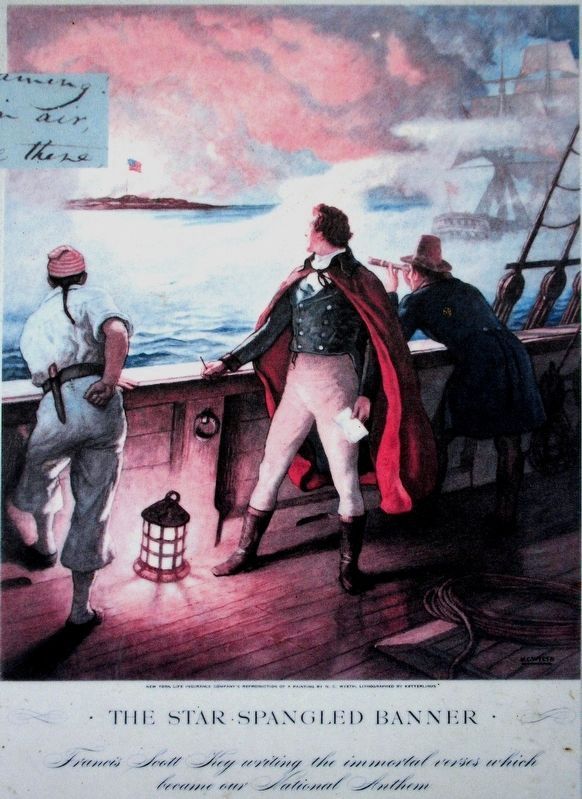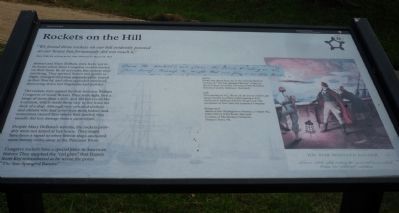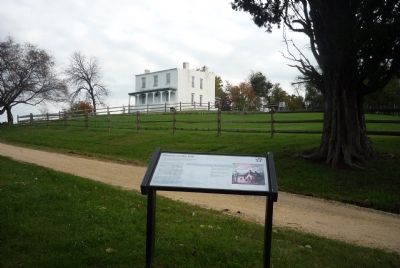Fort Washington in Prince George's County, Maryland — The American Northeast (Mid-Atlantic)
Rockets on the Hill
Oxon Cove Park
"We found three rockets on our hill evidently pointed at our house but fortunately did not reach it”
Mary DeButts, writing to her sister Millicent on March 18, 1815
Samuel and Mary DeButts were lucky not to be home when three Congreve rockets landed on their farm. By all accounts, the rockets were terrifying. They spewed flames and sparks in flight, changed direction unpredictably, roared as they flew by, and often exploded overhead, showering down hot fragments and powder.
The rockets were named for their inventor, William Congreve of Great Britain. They were light, had a range of more than a mile, and did not recoil like a cannon, which made them easy to fire from the deck of a ship. Although they petrified soldiers and citizens who had never seen them before, and sometimes caused fires where they landed, they usually did less damage than a cannonball.
Despite Mary DeButt’s worries, the rockets probably were not aimed at her house. They might have been a signal to other British ships anchored some twenty miles away in the Patuxent River.
Congreve rockets have a special place in American history. They supplied the “red glare” that Francis Scott Key remembered as he wrote the poem “The Star-Spangled Banner.”
Illustration captions:
Above: Detail, one stanza from one of the early handwritten versions of “The Star-Spangled Banner,” written in 1814 by Francis Scott Key. Courtesy of the Maryland Historical Society, Baltimore, Maryland
Left: This painting by N.C. Wyeth, By the Dawn’s Early Light shows Francis Scott Key (center) gazing at Fort McHenry in Baltimore Harbor. Image used with permission of New York Life Insurance Company.
Background: Attack on Fort Washington on Potomac, 17 August 1814, watercolor by Irwin Bevan, 1852-1940. Courtesy of The Mariner’s Museum, Newport News, VA.
Erected by National Park Service, U.S. Department of the Interior.
Topics. This historical marker is listed in these topic lists: Notable Events • War of 1812 • Waterways & Vessels. A significant historical date for this entry is March 18, 1815.
Location. 38° 48.178′ N, 77° 0.584′ W. Marker is in Fort Washington, Maryland, in Prince George's County. Marker is on Oxon Hill Road west of Bald Eagle Road, on the left when traveling west. Bald Eagle Road is accessible south of the the Capital Beltway (I-95/495) from Oxon Hill Road west of Indian Head Highway (MD 210). Touch for map. Marker is at or near this postal address: 6411 Oxon Hill Rd, Oxon Hill MD 20745, United States of America. Touch for directions.
Other nearby markers. At least 8 other markers are within walking distance of this marker. War Comes to Mount Welby
(within shouting distance of this marker); Mount Welby (about 400 feet away, measured in a direct line); The DeButts Family Comes to Maryland (about 400 feet away); The Burning of Washington, D.C. (about 400 feet away); Root Cellar (about 500 feet away); Wheat and Tobacco (about 500 feet away); Oxon Cove, the Potomac, and the Chesapeake (about 600 feet away); Why a Brick Stable? (about 700 feet away).
Additional keywords. Mount Welby; Royal Navy

Photographed By Allen C. Browne, September 17, 2011
4. The Star Spangled Banner
This painting by N.C. Wyeth, By the Dawn’s Early Light shows Francis Scott Key (center) gazing at Fort McHenry in Baltimore Harbor. Image used with permission of New York Life Insurance Company.Close-up of image on marker
Credits. This page was last revised on March 3, 2023. It was originally submitted on October 30, 2011, by Richard E. Miller of Oxon Hill, Maryland. This page has been viewed 718 times since then and 17 times this year. Photos: 1, 2. submitted on October 30, 2011, by Richard E. Miller of Oxon Hill, Maryland. 3, 4. submitted on December 24, 2016, by Allen C. Browne of Silver Spring, Maryland. • Bill Pfingsten was the editor who published this page.


